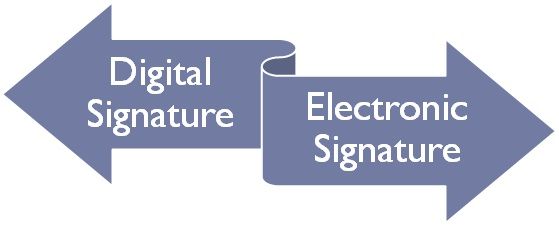 A Digital signature is a kind of Electronic signature, but are distinct. Digital Signature is more secure and tamper-evident, which encrypt the document and permanently embed the information in it if a user tries to commit any changes in the document then the digital signature will be invalidated. On the other hand, an Electronic Signature is similar to digitalized handwritten signature verified with the signer’s identity such as email, corporate ID’s, phone PIN etcetera.
A Digital signature is a kind of Electronic signature, but are distinct. Digital Signature is more secure and tamper-evident, which encrypt the document and permanently embed the information in it if a user tries to commit any changes in the document then the digital signature will be invalidated. On the other hand, an Electronic Signature is similar to digitalized handwritten signature verified with the signer’s identity such as email, corporate ID’s, phone PIN etcetera.
Conventionally signatures with a message were used to signify the identity and intention with regard to that particular message and its main purpose is to prove the ownership. Since years people have been using several types of signature to associate their identity and intention to the messages. For example, handwritten signature, seal, wax imprint, etc. These traditional approaches can be easily forged. Digitalization has given rise to the need of signing a digital document using digital techniques.
Content: Digital Signature and Electronic Signature
Comparison Chart
| Basis for comparison | Digital Signature | Electronic Signature |
|---|---|---|
| Basic | Digital signature can be visualised as an electronic "fingerprint", that is encrypted and identifies the person's identity who actually signed it. | Electronic signature could be any symbol, image, process attached to the message or document signifies the signer's identity and act an consent on it. |
| Authentication mechanism | Certificate-based digital ID | Verifies signers identity through email, phone PIN, etc. |
| Used for | Securing a document. | Verifying a document. |
| Validation | Performed by trusted certificate authorities or trust service providers. | No specific validation process. |
| Security | Highly secure | Vulnerable to tampering |
Definition of Digital Signature
The Digital Signature is a type of electronic signature and follows the particular standards. It imparts independent verification and tamper evidence. The verification of digital signatures is done by the trusted third party commonly referred to a Certificate Authority.
Certificate authorities bind the user’s identity to a PKI-based digital certificate which allows the user to apply digital signatures to the document and the cloud-based signing platforms. When a digital signature is employed to a document, a cryptographic operation attaches digital certificate with the data into one unique fingerprint.
The message is signed by the private key of the sender which is only known to him/her; this ensures authentication of the message source. The message and its signature cannot be changed thenceforth signing a message. Sender and receiver do not have to worry about transit alteration without the private key, the message and its signature could never be altered. The sender of the message cannot refuse having signed a signature if it is valid. Digital signature distinctively correlates with the corresponding message and renders integrity.
Digital signatures need not separate from a message or document for using it in another document. These types of signatures depend on the document as well as on the signer.
Digital signature scheme steps:
- Key generation: The public key and its correlated private key of the user is computed in this step.
- Signing: The corresponding message is signed by the user with his/her private key.
- Verification: In this step, the signature for a provided message against the public key is verified.
Definition of Electronic Signature
Electronic Signatures use a technology that binds the signature to the signer’s identity and the time it was signed. An electronic signature could be a process attached, electronic symbol or sound to a message, contract or document which can be used to get consent or approval on electronic documents or forms. Electronic signatures are a substitute for handwritten signatures in practically each personal or business process.
It uses general electronic authentication technique to justify signer identity, such as email, corporate ID etc. When security needed to be enhanced multifactor authentication can also be used. The efficient e-signature solutions indicate proof of signing by utilizing a secure process of audit trail along with the final document. It does not use encryption and is not secure enough to find the tampering like digital signature.
Key Differences Between Digital Signature and Electronic Signature
- Digital signatures are consistently time-stamped while in electronic signature date and time can be associated with it but placed separately.
- Digital Signatures comply the standards and enhance security by using cryptographic encryption methods. As against, electronic signatures does not depend on standards and tend to be less secure comparatively.
- Authentication mechanism used in the electronic signature is not defined and uses signer’s email, phone PIN, etc. In contrast, digital signature involves certificate-based digital ID authentication method.
- Digital signature ensures the security of the digital document whereas electronic signature is used for verifying the digital document.
- In the digital signature, the signature validation is performed by the trusted certificate authorities while it is not the case in electronic signature.
- Electronic signatures are prone to tampering. On the contrary, digital signatures are highly secured and offer tamper evidence.
Conclusion
The terms digital signature and electronic signature are occasionally used interchangeably, but there exists a large difference between them. Although, their purposes would overlap, i.e., authenticating a digital document. Digital signatures is widely used and more secure than electronic signatures.
Joseph Martinez says
Very informative….
Shiva Infotech says
Very nice Blog. This blog is very informative and very useful for me to know about the benefits of bulk pdf signer.
Paula Williams says
Hi
I read your blog and found it very helpful, thanks for sharing.